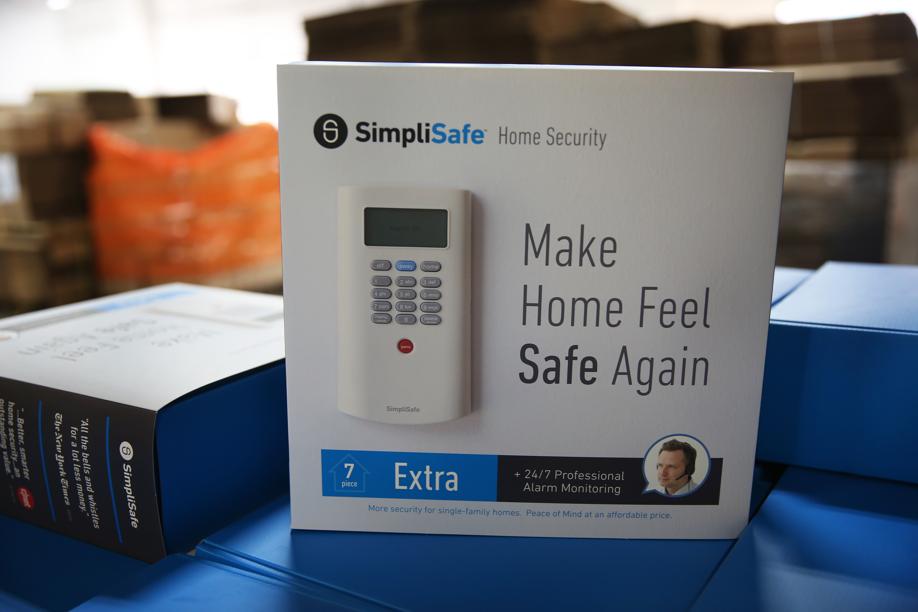


There comes that point in every successful startup’s life when the sleeping giant with whom they compete has hit the snooze button a few times and finally has no choice but to get up.
This week could mark that moment for SimpliSafe, one of Boston’s fastest-growing startups. You may have heard about it on radio, on TV, or through Facebook ads. The Boston company sells home security systems that you install yourself, with prices starting at about $200. And there’s also no need to sign a lengthy contract for central monitoring services; you can purchase that at $15 a month, or not.
It’s a product that exploits a weakness in the way big home security companies like ADT sell. The weakness? The big guys rely on armies of salespeople and a franchised network of dealers; both groups are motivated to sell you as much equipment as possible and to persuade you to sign a monitoring contract that lasts as long as possible.
As a result, they miss a sizeable customer base: people who move often and live in residences they don’t own. SimpliSafe cofounders Chad and Eleanor Laurans, who were attending Harvard Business School, came up with the idea for the company a decade ago after several friends had apartment break-ins.
“When they tried to figure out what to do about it, they came up empty,’’ Eleanor Laurans says. “Some of them called traditional alarm companies like ADT, but many weren’t in a place in their life where they wanted to sign a three-year contract.’’
One of Eleanor Laurans’s professors was Clay Christensen, author of “The Innovator’s Dilemma,’’ an influential book about how an industry’s biggest players can overlook customers that at first glance appear unprofitable. In this case, how could you possibly make money installing security systems for apartment renters who moved every few years?
The answer was to eliminate the installer and design an alarm system that people could set up themselves. While Eleanor Laurans went to work at a consulting firm to pay the bills, Chad Laurans worked on the design of the components. “We had a soldering iron on our kitchen counter for about two years,’’ she recalls. They’d bring prototypes over to friends’ apartments and watch them install the motion sensors and keypads, taking notes and discussing afterward what was confusing.
From 2006 to 2008, SimpliSafe was a one-person operation, headquartered in the Lauranses’ apartment. The product finally hit the market in 2009.
When Chad Laurans went to security industry trade shows, he says, “People explained to me that the whole industry operates based on long-term contracts. Everyone thought it was nuts not to have customers sign a contract.’’
It was also a challenge to make homeowners aware that it was possible to install their own security system. The Lauranses focused on trying to get websites like Apartment Therapy and TechCrunch to review the product, and buying ads on search engines and social networks.
Today, the company offers a range of equipment, including glass-break detectors, panic buttons, and water sensors for basements. All of them can send alerts to, or be controlled by, a smartphone. SimpliSafe had 100 employees at the start of 2015 and ended the year with almost 250. BestBuy and Walmart also began carrying its products in November.
Nick Heymann, an equities analyst who covers ADT for the Chicago investment firm William Blair & Co., says about 26 million homes in the United States have installed traditional alarm systems, but the number has plateaued in recent years.
SimpliSafe, by contrast, has built a business by selling to people who haven’t bought a traditional system. “They saw them as too expensive, too difficult, too cumbersome,’’ Chad Laurans says. And some customers wanted to install sensors that alerted only them about occurrences in their home, rather than summoning the police.
“People use them on closets more than you’d think,’’ Chad Laurans says. “They keep their financial documents in a closet, and they don’t want the nanny going in.’’ He estimates that the market for self-installed, buy-what-you-need security systems could be twice as big as 26 million homes.
Cambridge venture capitalist Eric Paley, who isn’t an investor in SimpliSafe, but has followed the company, estimates SimpliSafe’s revenues already exceed $100 million annually. (The company, privately held, doesn’t disclose financials.) In 2014, SimpliSafe raised $57 million in venture capital.
Established home security companies, Paley says, “are very beholden to their existing sales channels — the installers — and they’re not innovators to begin with.’’
One of the incumbents, Florida-based ADT, will try to change that perception this week at the Consumer Electronics Show in Las Vegas. ADT will debut a new product, developed with the South Korean electronics giant LG, that is a direct response to SimpliSafe and other startups selling low-cost security gear free of annual contracts.
ADT didn’t want to talk about product specifics in advance of the trade show, but Heymann, the analyst, expects LG Smart Security to sell for under $300, with monitoring service provided by ADT for about $20 a month. Like SimpliSafe, it will target “highly mobile, younger workers, or students in an apartment,’’ Heymann says.
Having roused the security industry’s giant will make 2016 a very interesting year for SimpliSafe. And things will get even more interesting if big tech players like Google, which already owns Nest, a maker of smart thermostats and smoke detectors, jump in.
A decade ago, security was “an industry that was so sleepy,’’ Chad Laurans says, “that people expected no change at all.’’ Now that things are changing, and big companies and other startups are emulating its strategy, the challenge will be for SimpliSafe to continue to stand out.
Scott Kirsner can be reached at kirsner@pobox.com. Follow him on Twitter @ScottKirsner and on betaboston.com.


 PREVIOUS ARTICLE
PREVIOUS ARTICLE